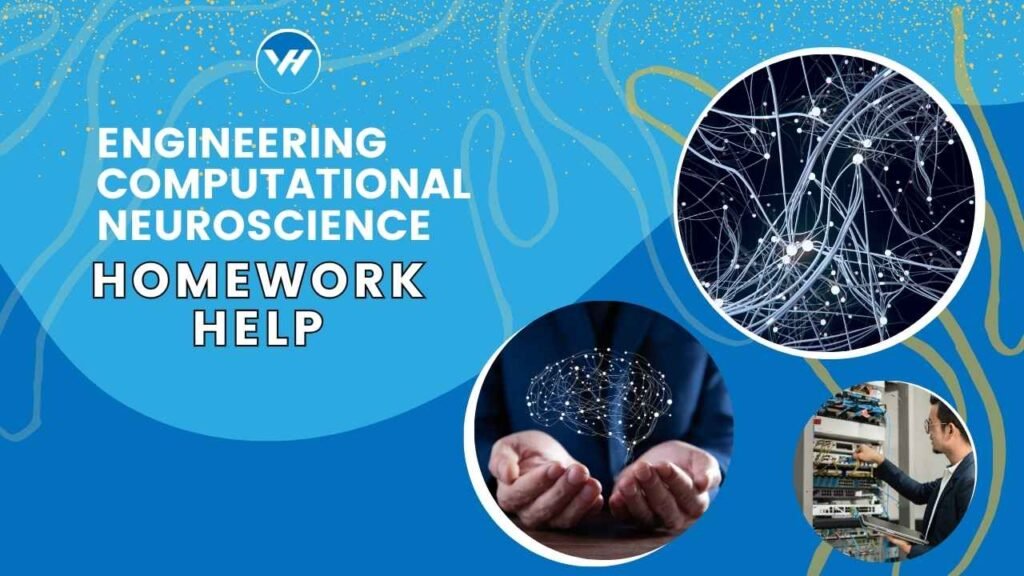Navigating the intricate world of engineering computational neuroscience can be challenging. This specialized field combines elements of neuroscience, engineering, and computer science to understand and model brain functions. As students dive into this fascinating subject, they often encounter complex homework that requires both technical skill and deep understanding. Seeking homework help can make a significant difference, ensuring that you not only complete assignments but truly grasp the concepts. In this article, we’ll explore how you can leverage resources, especially Virtual Help, to tackle your computational neuroscience homework effectively.

Table of Contents
ToggleWhat is Computational Neuroscience?
Computational neuroscience is a branch of neuroscience that uses mathematical models and computational techniques to understand the brain’s structure and function. It involves simulating neural processes and analyzing data to gain insights into how the brain processes information. Key concepts include neural networks, brain mapping, and the dynamics of neuronal activity. By applying engineering principles, computational neuroscience can create models that help predict brain behavior and simulate cognitive functions.
The Role of Engineering in Computational Neuroscience
Engineering plays a crucial role in computational neuroscience by providing tools and methodologies for creating and analyzing complex neural models. Engineers use algorithms, data analysis techniques, and simulation tools to model brain activity and understand neural processes. Applications range from designing brain-machine interfaces to developing advanced neuroimaging techniques. This interdisciplinary approach enhances our ability to study the brain and develop new technologies for medical and research purposes.
Challenges in Computational Neuroscience Homework
Students working on computational neuroscience assignments often face several challenges. The complexity of mathematical models used in this field can be overwhelming, especially when integrating diverse data sources. Issues like understanding neural network architectures, dealing with large datasets, and applying algorithms correctly are common hurdles. Additionally, the interdisciplinary nature of the subject means that students must be proficient in both neuroscience concepts and engineering principles.
Why Seek Homework Help?
Professional homework help can provide several benefits. For one, it offers targeted assistance with complex problems, ensuring that you understand the underlying concepts rather than just completing the assignment. Homework help can also improve your academic performance by offering personalized guidance and support. By working with experts, you gain insights into best practices and methodologies that enhance your learning experience.
Types of Computational Neuroscience Assignments
Assignments in computational neuroscience can vary widely, but they often include:
- Mathematical Modeling: Creating and analyzing mathematical representations of neural systems.
- Data Analysis: Processing and interpreting experimental data from neuroimaging or electrophysiological studies.
- Simulation and Programming: Developing simulations to model brain activity and running computational experiments.
Understanding these types of assignments can help you better prepare for your homework and seek the right kind of help.
How to Find the Right Help for Your Homework
Finding the right help involves knowing where to look and what to seek. Here are a few tips:
- Online Tutoring Platforms: Many platforms offer specialized tutoring in computational neuroscience and related fields.
- Specialized Tutors: Look for tutors with expertise in both neuroscience and engineering.
- Virtual Help: A comprehensive platform that connects you with tutors and resources tailored to your needs.
Using Virtual Help for Computational Neuroscience Homework
Virtual Help is an excellent resource for students needing assistance with computational neuroscience homework. The platform provides access to qualified tutors and a variety of tools to support your learning. Here’s how you can use Virtual Help effectively:
- Explore Available Tutors: Find tutors with experience in computational neuroscience and engineering.
- Schedule Sessions: Set up one-on-one sessions to get personalized help.
- Utilize Resources: Make use of the platform’s resources, including study guides and practice problems.
Tips for Maximizing Your Homework Help Experience
To get the most out of your homework help sessions, consider these tips:
- Communicate Clearly: Provide detailed information about your assignment and specific areas where you need help.
- Set Goals and Deadlines: Work with your tutor to establish clear goals and deadlines for your homework.
- Prepare for Sessions: Review your notes and try to solve problems on your own before seeking help.
Common Mistakes to Avoid
Avoid these common pitfalls:
- Misunderstanding Assignment Requirements: Ensure you fully understand what is being asked before starting your work.
- Poor Time Management: Allocate sufficient time for each part of your assignment and avoid last-minute rushes.
Resources for Further Learning
To deepen your understanding of computational neuroscience, consider these resources:
- Recommended Books: “Computational Neuroscience: A Comprehensive Approach” and “Principles of Computational Modelling in Neuroscience”.
- Online Courses: Look for courses on platforms like Coursera or edX that focus on computational neuroscience and related fields.
The Future of Computational Neuroscience
The field of computational neuroscience is rapidly evolving with advancements in technology and data analysis. Emerging trends include the development of more sophisticated neural network models and new neuroimaging techniques. Homework help plays a crucial role in keeping students and researchers up-to-date with these advancements, ensuring they contribute to the field’s progress.
Conclusion
Navigating the complexities of engineering computational neuroscience can be daunting, but seeking homework help can make a significant difference. Platforms like Virtual Help provide valuable resources and support, enabling you to tackle assignments with confidence. By understanding the role of engineering in neuroscience and utilizing available tools, you can enhance your learning experience and achieve academic success.
FAQs
- What is Computational Neuroscience? Computational neuroscience is the study of brain function through mathematical models and computational techniques.
- How can engineering aid in computational neuroscience? Engineering provides tools and methods for modeling, simulating, and analyzing neural processes.
- What are the benefits of using Virtual Help? Virtual Help offers access to specialized tutors and resources tailored to your needs, enhancing your learning experience.
- How can I choose the right tutor for my needs? Look for tutors with expertise in both neuroscience and engineering and check their reviews and qualifications.
- What are some effective study strategies for computational neuroscience? Review key concepts regularly, practice problem-solving, and seek help when needed to reinforce your understanding.





